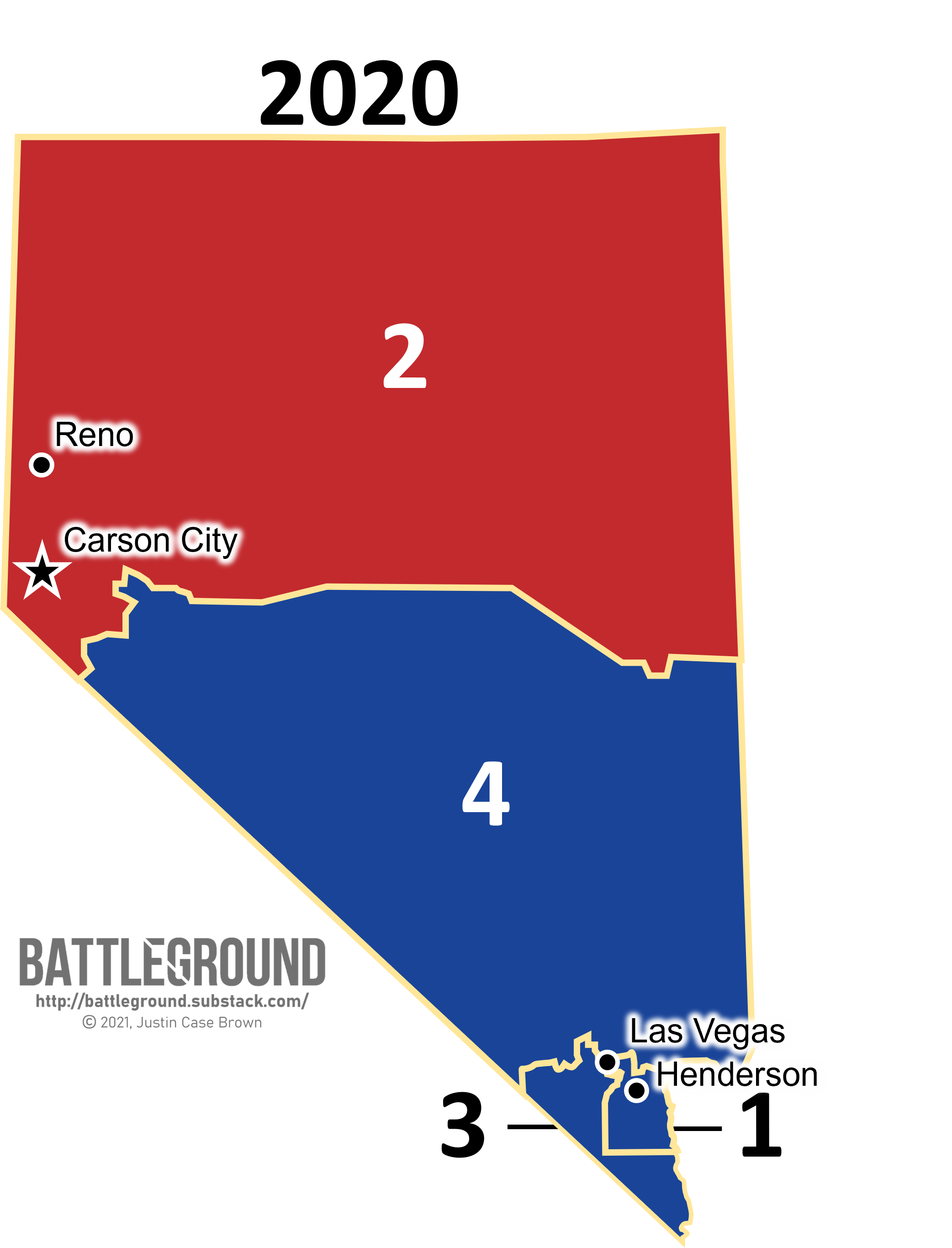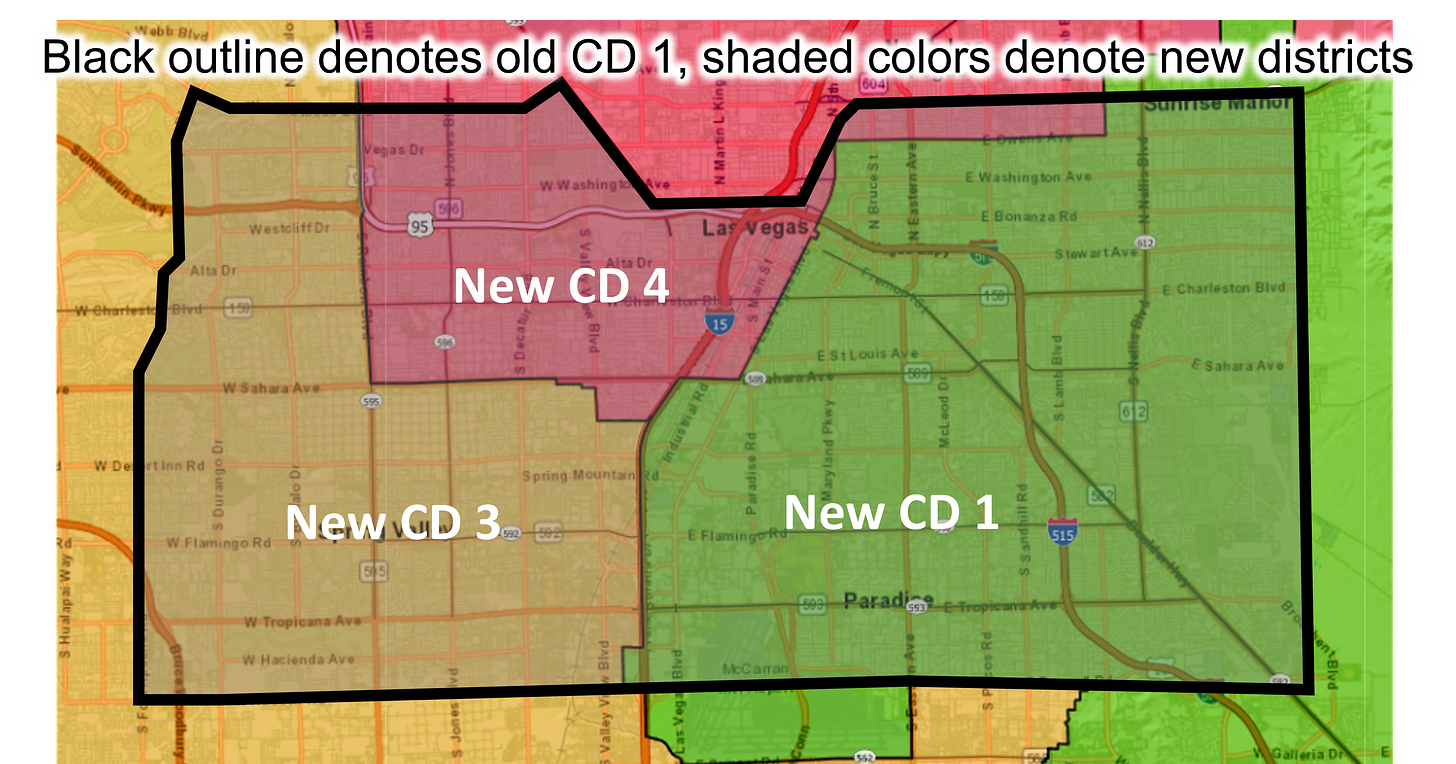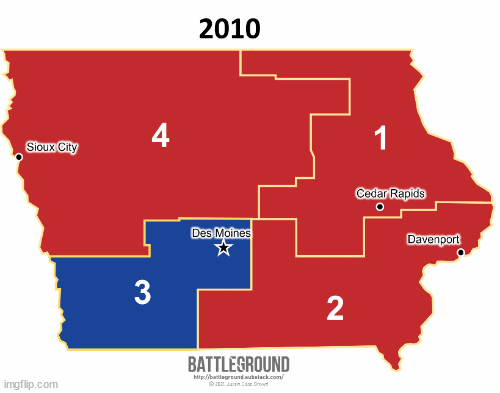Nevada: Unpacking Las Vegas
The state's non-white majority finally receives adequate representation.

Topline Takeaways
- Changes in Nevada’s congressional districts are centered in Las Vegas as the city holds nearly 70% of the state’s population.
- Democrats have complete control of the redistricting process in Nevada. They chose to sacrifice a single “packed” district in Las Vegas in exchange for three swing districts that lean Democratic.
- Much attention was paid to Las Vegas’s many ethnic communities to ensure adequate representation and prevent legal challenges.
New District Breakdown

Changes in Nevada’s congressional districts fall primarily in Las Vegas. Three of the state’s four districts are anchored in the city since it holds nearly 70% of Nevada’s total population. In the previous map, a 43 square mile rectangle was drawn around the city center and was designated NV-1. The old NV-3 and NV-4 split the surrounding areas with North Las Vegas going to the latter and the southern suburbs like Henderson going to the former. The new congressional district map takes a completely different approach to mapping the city’s districts:

Nevada’s new district map unpacks the downtown area of Las Vegas where much of the state’s Democratic voters reside. Instead of bunching their voters into a single district that regularly supported the party by 30 points or more, Democrats are cracking their coalition in hopes that a “divide and conquer” strategy can help them hold onto more seats. With the erasure of the old NV-1, the northern “cut” of NV-4 dips further south, pulling in many heavily Democratic precincts that lie just west of the downtown area. Democrats hope this influx of urban voters into a new NV-4 will offset conservative, rural voters that reside in the northern reaches of the district, hundreds of miles away from Vegas.
Shifting Suburbs
While the cracking of NV-1 is the most noticeable change at first glance, some of the most impactful changes to Nevada’s congressional districts lie in the Las Vegas suburbs as many of its wealthier suburban neighborhoods switched districts. Summerlin is a master-planned community lying northwest of the city and was named one of the Best Places to Live in America by Money Magazine in 2014. The median household income in Summerlin is almost double that of the Las Vegas metro area as a whole. In 2020, voters from Summerlin precincts overwhelmingly supported Joe Biden and this block of wealthy Democrats have been transferred from NV-4 into NV-3. Nevada’s new third congressional district also now includes more of the western suburbs of the Las Vegas Valley including Spring Valley, known locally for its “Chinatown” that has become a hub for pan-Asian businesses in the region.
Summerlin steps into NV-3 to replace Henderson, another wealthy suburb that lies to the southeast of Las Vegas. The new map removes Henderson from its previous home in NV-3 and groups the community with the incredibly Democratic working class coalition in East Las Vegas to form the new NV-1. This is particularly important as precincts in and around Henderson largely supported Donald Trump in 2020. Democrats are hoping that their coalition of voters in East Las Vegas will outnumber Republican voters in these southern suburbs.
Altogether, Democrats are hoping that sacrificing an all-but-guaranteed blue seat anchored in downtown Vegas will lead to three seats that tilt in their favor.
Since Democrats were laser-focused on Las Vegas, they let the state’s second congressional district stand mostly untouched as it leans reliably toward Republicans. The most significant shift in NV-2 is the inclusion of White Pine county and its 10,000 residents, formerly part of NV-4. The shift allows the state’s fourth congressional district to lean more heavily on voters in Las Vegas as mentioned above.
Who Is In Control?
Like Oregon, Nevada’s redistricting process is completely controlled by the state legislature and requires gubernatorial approval before being adopted. Democrats are firmly in the drivers seat here as they hold a trifecta: majorities in both houses alongside a Democratic governor.
Cracking, Packing, Kidnapping or Hijacking?
Since Las Vegas is an incredibly diverse city, redistricting invites many concerns about representation for ethnic communities. In this cycle, many Asian Americans applauded the new map as it put the entire Spring Valley community into NV-3. Groups like the Asian Community Development Council and the American Civil Liberties Union of Nevada were pushing Democrats to draw districts that would increase the power of the Asian American and Pacific Islander (AAPI) community and encourage voter participation.
“When people that look like them represent them, then the community gets involved more. When they don’t see people representing them who look like them, they don’t really participate.”
-Eric Jeng of Nevada’s Asian Community Development Council
Meanwhile, Democrats’ decision to unpack the old first district in downtown Las Vegas resulted in a slight cracking of the city’s Latine population. In the old NV-1, Latine voters made up roughly 45% of the electorate. The new NV-1 drops that number down to 35%.
“As of right now, [NV-1] is pro-working families and pro-immigration reform. That’s really important for electing representatives. If we separate the Latine community, it’ll be harder to elect someone who directly understands what the community needs.”
-Maria Nieto Orta, political director of Mi Familia Vota
Democratic legislators responded by questioning the legality of the old first district as they worried that with population shifts over the last decade, it might have created a majority-minority district that risked violating tests for racial gerrymandering. The conundrum illustrates a perennial challenge for ethnic minority groups facing redistricting. Both packing and cracking ethnic communities can be deemed a racial gerrymander as both tactics can be used to dilute the voting power of the group. In this case, the test will be if the new NV-1 favors more moderate candidates that primarily appeal to affluent Henderson voters. If so, expect Latine voters to challenge the congressional map as it would be clear evidence that unpacking the old NV-1 resulted in decreased representation for a large Latine community.
While the new map doesn’t meet the demands of all communities in Nevada, it helps bring the districts in line with the demographics of the entire state. Despite having one of the highest proportions of nonwhite residents in the nation (51%), none of Nevada’s previous congressional districts had a majority non-white population when originally drawn in 2010. The new map creates three districts with majority non-white populations that mirror the state’s overall makeup.
“Maps passed today reflect our diverse and vibrant state and set us on a path for the next ten years where the voices of all those who call Nevada home are represented.”
-Joint Statement by Nevada Assembly Speaker Jason Frierson and Nevada Senate Majority Leader Nicole Cannizzaro
Leftover Links
- Check out my previous post on Nevada, examining the state’s impactful unions and gun culture.
- Nevada Republicans only waited one day before submitting legal challenges to the new map.




